Critical Appraisal of a Research Paper on Drug Use at Festivals
VerifiedAdded on 2022/10/19
|7
|1804
|388
Report
AI Summary
This report critically appraises a research paper by Day et al. (2018) investigating illicit drug use, knowledge, and practices among music festival attendees. The analysis covers authorship, research questions, design, methods, results, and limitations of the study. The study employed a survey method to gather quantitative data on participants' drug use patterns and attitudes toward drug testing. The findings revealed high rates of illicit drug use, with participants generally supporting drug testing as a means of harm reduction. The report further discusses the application of the study's evidence to practice, emphasizing the importance of harm reduction strategies and addressing the concerns of parents. It concludes by highlighting the need for further research to replicate drug testing in harm reduction and address the challenges of implementing these strategies.
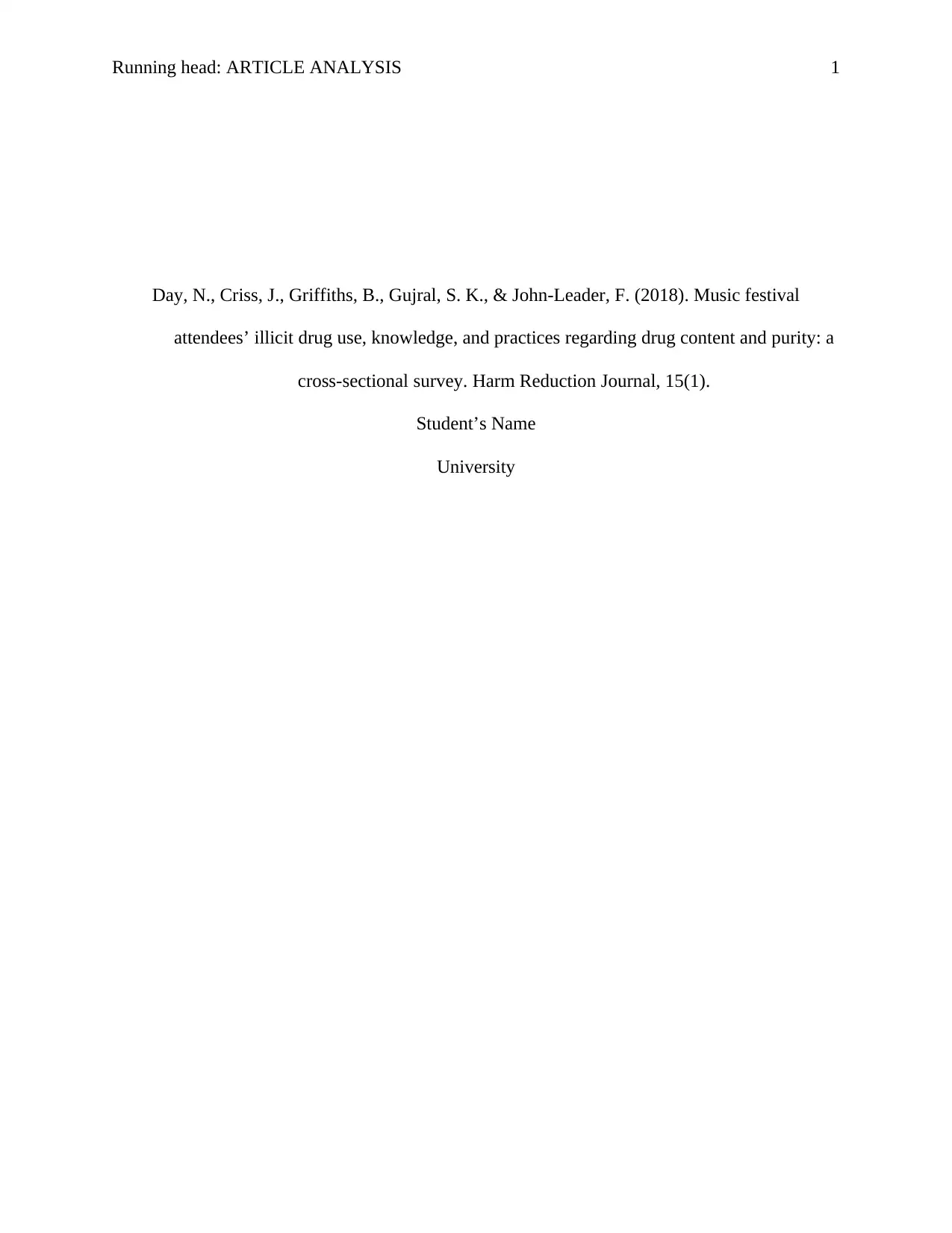
Running head: ARTICLE ANALYSIS 1
Day, N., Criss, J., Griffiths, B., Gujral, S. K., & John-Leader, F. (2018). Music festival
attendees’ illicit drug use, knowledge, and practices regarding drug content and purity: a
cross-sectional survey. Harm Reduction Journal, 15(1).
Student’s Name
University
Day, N., Criss, J., Griffiths, B., Gujral, S. K., & John-Leader, F. (2018). Music festival
attendees’ illicit drug use, knowledge, and practices regarding drug content and purity: a
cross-sectional survey. Harm Reduction Journal, 15(1).
Student’s Name
University
Paraphrase This Document
Need a fresh take? Get an instant paraphrase of this document with our AI Paraphraser
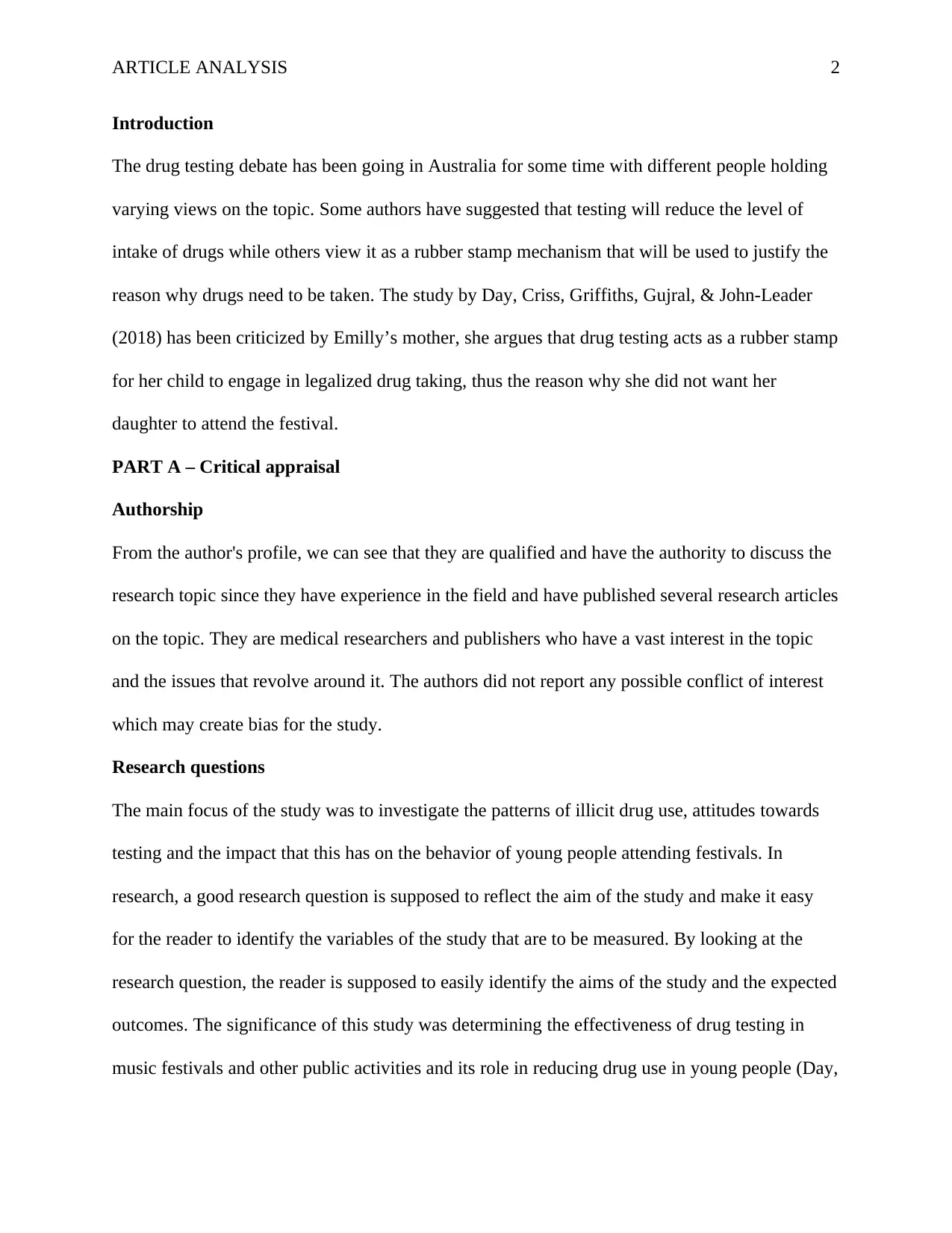
ARTICLE ANALYSIS 2
Introduction
The drug testing debate has been going in Australia for some time with different people holding
varying views on the topic. Some authors have suggested that testing will reduce the level of
intake of drugs while others view it as a rubber stamp mechanism that will be used to justify the
reason why drugs need to be taken. The study by Day, Criss, Griffiths, Gujral, & John-Leader
(2018) has been criticized by Emilly’s mother, she argues that drug testing acts as a rubber stamp
for her child to engage in legalized drug taking, thus the reason why she did not want her
daughter to attend the festival.
PART A – Critical appraisal
Authorship
From the author's profile, we can see that they are qualified and have the authority to discuss the
research topic since they have experience in the field and have published several research articles
on the topic. They are medical researchers and publishers who have a vast interest in the topic
and the issues that revolve around it. The authors did not report any possible conflict of interest
which may create bias for the study.
Research questions
The main focus of the study was to investigate the patterns of illicit drug use, attitudes towards
testing and the impact that this has on the behavior of young people attending festivals. In
research, a good research question is supposed to reflect the aim of the study and make it easy
for the reader to identify the variables of the study that are to be measured. By looking at the
research question, the reader is supposed to easily identify the aims of the study and the expected
outcomes. The significance of this study was determining the effectiveness of drug testing in
music festivals and other public activities and its role in reducing drug use in young people (Day,
Introduction
The drug testing debate has been going in Australia for some time with different people holding
varying views on the topic. Some authors have suggested that testing will reduce the level of
intake of drugs while others view it as a rubber stamp mechanism that will be used to justify the
reason why drugs need to be taken. The study by Day, Criss, Griffiths, Gujral, & John-Leader
(2018) has been criticized by Emilly’s mother, she argues that drug testing acts as a rubber stamp
for her child to engage in legalized drug taking, thus the reason why she did not want her
daughter to attend the festival.
PART A – Critical appraisal
Authorship
From the author's profile, we can see that they are qualified and have the authority to discuss the
research topic since they have experience in the field and have published several research articles
on the topic. They are medical researchers and publishers who have a vast interest in the topic
and the issues that revolve around it. The authors did not report any possible conflict of interest
which may create bias for the study.
Research questions
The main focus of the study was to investigate the patterns of illicit drug use, attitudes towards
testing and the impact that this has on the behavior of young people attending festivals. In
research, a good research question is supposed to reflect the aim of the study and make it easy
for the reader to identify the variables of the study that are to be measured. By looking at the
research question, the reader is supposed to easily identify the aims of the study and the expected
outcomes. The significance of this study was determining the effectiveness of drug testing in
music festivals and other public activities and its role in reducing drug use in young people (Day,
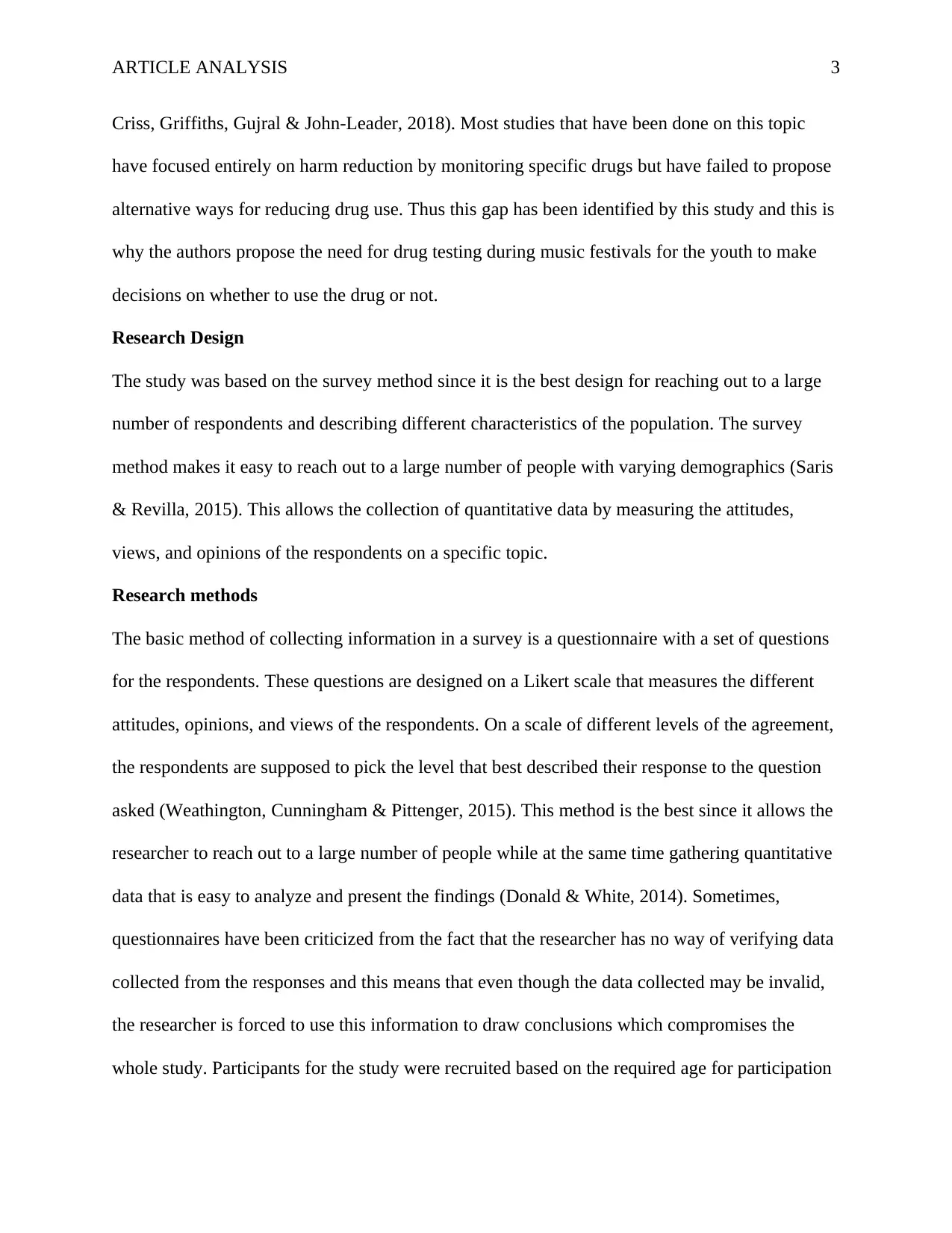
ARTICLE ANALYSIS 3
Criss, Griffiths, Gujral & John-Leader, 2018). Most studies that have been done on this topic
have focused entirely on harm reduction by monitoring specific drugs but have failed to propose
alternative ways for reducing drug use. Thus this gap has been identified by this study and this is
why the authors propose the need for drug testing during music festivals for the youth to make
decisions on whether to use the drug or not.
Research Design
The study was based on the survey method since it is the best design for reaching out to a large
number of respondents and describing different characteristics of the population. The survey
method makes it easy to reach out to a large number of people with varying demographics (Saris
& Revilla, 2015). This allows the collection of quantitative data by measuring the attitudes,
views, and opinions of the respondents on a specific topic.
Research methods
The basic method of collecting information in a survey is a questionnaire with a set of questions
for the respondents. These questions are designed on a Likert scale that measures the different
attitudes, opinions, and views of the respondents. On a scale of different levels of the agreement,
the respondents are supposed to pick the level that best described their response to the question
asked (Weathington, Cunningham & Pittenger, 2015). This method is the best since it allows the
researcher to reach out to a large number of people while at the same time gathering quantitative
data that is easy to analyze and present the findings (Donald & White, 2014). Sometimes,
questionnaires have been criticized from the fact that the researcher has no way of verifying data
collected from the responses and this means that even though the data collected may be invalid,
the researcher is forced to use this information to draw conclusions which compromises the
whole study. Participants for the study were recruited based on the required age for participation
Criss, Griffiths, Gujral & John-Leader, 2018). Most studies that have been done on this topic
have focused entirely on harm reduction by monitoring specific drugs but have failed to propose
alternative ways for reducing drug use. Thus this gap has been identified by this study and this is
why the authors propose the need for drug testing during music festivals for the youth to make
decisions on whether to use the drug or not.
Research Design
The study was based on the survey method since it is the best design for reaching out to a large
number of respondents and describing different characteristics of the population. The survey
method makes it easy to reach out to a large number of people with varying demographics (Saris
& Revilla, 2015). This allows the collection of quantitative data by measuring the attitudes,
views, and opinions of the respondents on a specific topic.
Research methods
The basic method of collecting information in a survey is a questionnaire with a set of questions
for the respondents. These questions are designed on a Likert scale that measures the different
attitudes, opinions, and views of the respondents. On a scale of different levels of the agreement,
the respondents are supposed to pick the level that best described their response to the question
asked (Weathington, Cunningham & Pittenger, 2015). This method is the best since it allows the
researcher to reach out to a large number of people while at the same time gathering quantitative
data that is easy to analyze and present the findings (Donald & White, 2014). Sometimes,
questionnaires have been criticized from the fact that the researcher has no way of verifying data
collected from the responses and this means that even though the data collected may be invalid,
the researcher is forced to use this information to draw conclusions which compromises the
whole study. Participants for the study were recruited based on the required age for participation
⊘ This is a preview!⊘
Do you want full access?
Subscribe today to unlock all pages.

Trusted by 1+ million students worldwide
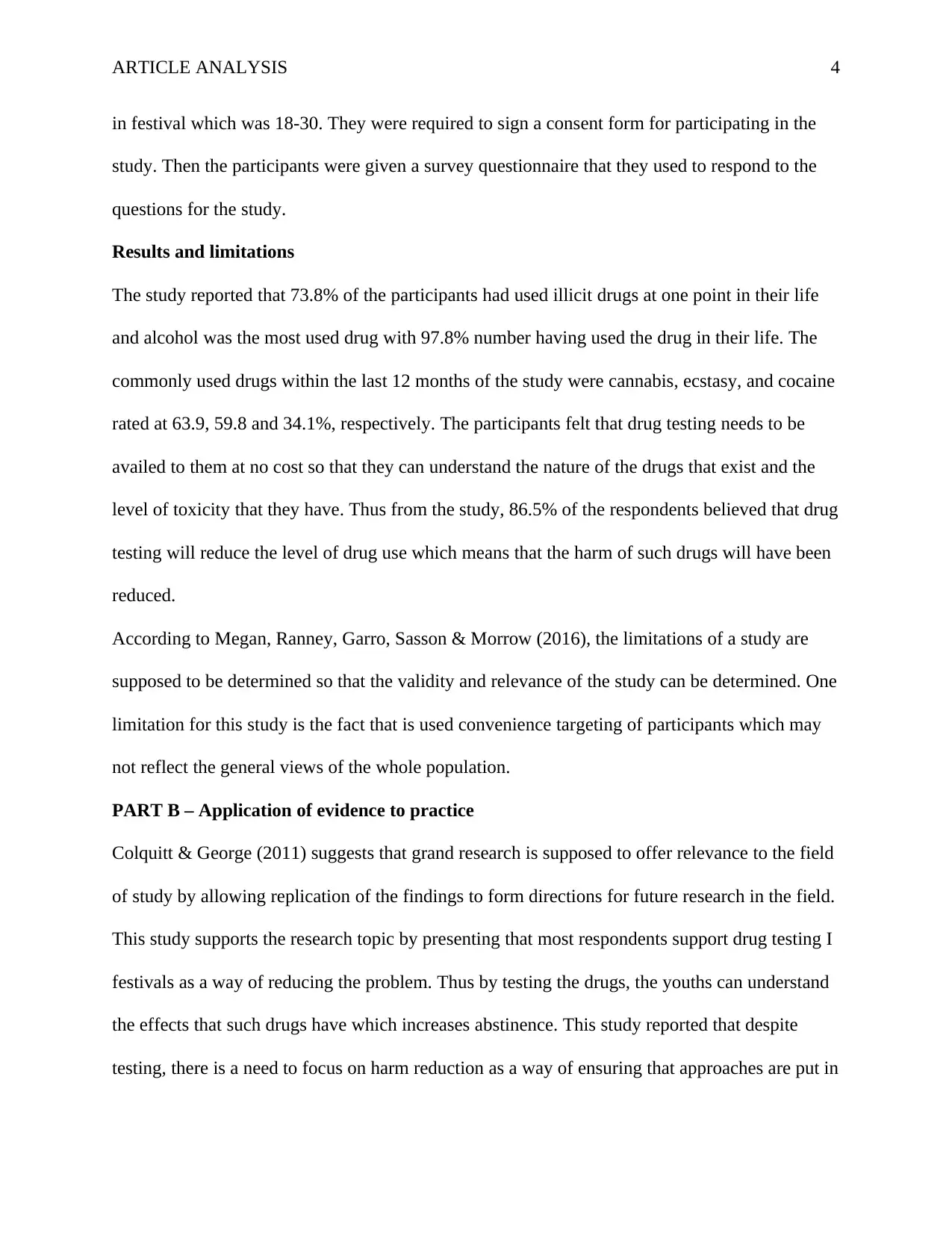
ARTICLE ANALYSIS 4
in festival which was 18-30. They were required to sign a consent form for participating in the
study. Then the participants were given a survey questionnaire that they used to respond to the
questions for the study.
Results and limitations
The study reported that 73.8% of the participants had used illicit drugs at one point in their life
and alcohol was the most used drug with 97.8% number having used the drug in their life. The
commonly used drugs within the last 12 months of the study were cannabis, ecstasy, and cocaine
rated at 63.9, 59.8 and 34.1%, respectively. The participants felt that drug testing needs to be
availed to them at no cost so that they can understand the nature of the drugs that exist and the
level of toxicity that they have. Thus from the study, 86.5% of the respondents believed that drug
testing will reduce the level of drug use which means that the harm of such drugs will have been
reduced.
According to Megan, Ranney, Garro, Sasson & Morrow (2016), the limitations of a study are
supposed to be determined so that the validity and relevance of the study can be determined. One
limitation for this study is the fact that is used convenience targeting of participants which may
not reflect the general views of the whole population.
PART B – Application of evidence to practice
Colquitt & George (2011) suggests that grand research is supposed to offer relevance to the field
of study by allowing replication of the findings to form directions for future research in the field.
This study supports the research topic by presenting that most respondents support drug testing I
festivals as a way of reducing the problem. Thus by testing the drugs, the youths can understand
the effects that such drugs have which increases abstinence. This study reported that despite
testing, there is a need to focus on harm reduction as a way of ensuring that approaches are put in
in festival which was 18-30. They were required to sign a consent form for participating in the
study. Then the participants were given a survey questionnaire that they used to respond to the
questions for the study.
Results and limitations
The study reported that 73.8% of the participants had used illicit drugs at one point in their life
and alcohol was the most used drug with 97.8% number having used the drug in their life. The
commonly used drugs within the last 12 months of the study were cannabis, ecstasy, and cocaine
rated at 63.9, 59.8 and 34.1%, respectively. The participants felt that drug testing needs to be
availed to them at no cost so that they can understand the nature of the drugs that exist and the
level of toxicity that they have. Thus from the study, 86.5% of the respondents believed that drug
testing will reduce the level of drug use which means that the harm of such drugs will have been
reduced.
According to Megan, Ranney, Garro, Sasson & Morrow (2016), the limitations of a study are
supposed to be determined so that the validity and relevance of the study can be determined. One
limitation for this study is the fact that is used convenience targeting of participants which may
not reflect the general views of the whole population.
PART B – Application of evidence to practice
Colquitt & George (2011) suggests that grand research is supposed to offer relevance to the field
of study by allowing replication of the findings to form directions for future research in the field.
This study supports the research topic by presenting that most respondents support drug testing I
festivals as a way of reducing the problem. Thus by testing the drugs, the youths can understand
the effects that such drugs have which increases abstinence. This study reported that despite
testing, there is a need to focus on harm reduction as a way of ensuring that approaches are put in
Paraphrase This Document
Need a fresh take? Get an instant paraphrase of this document with our AI Paraphraser
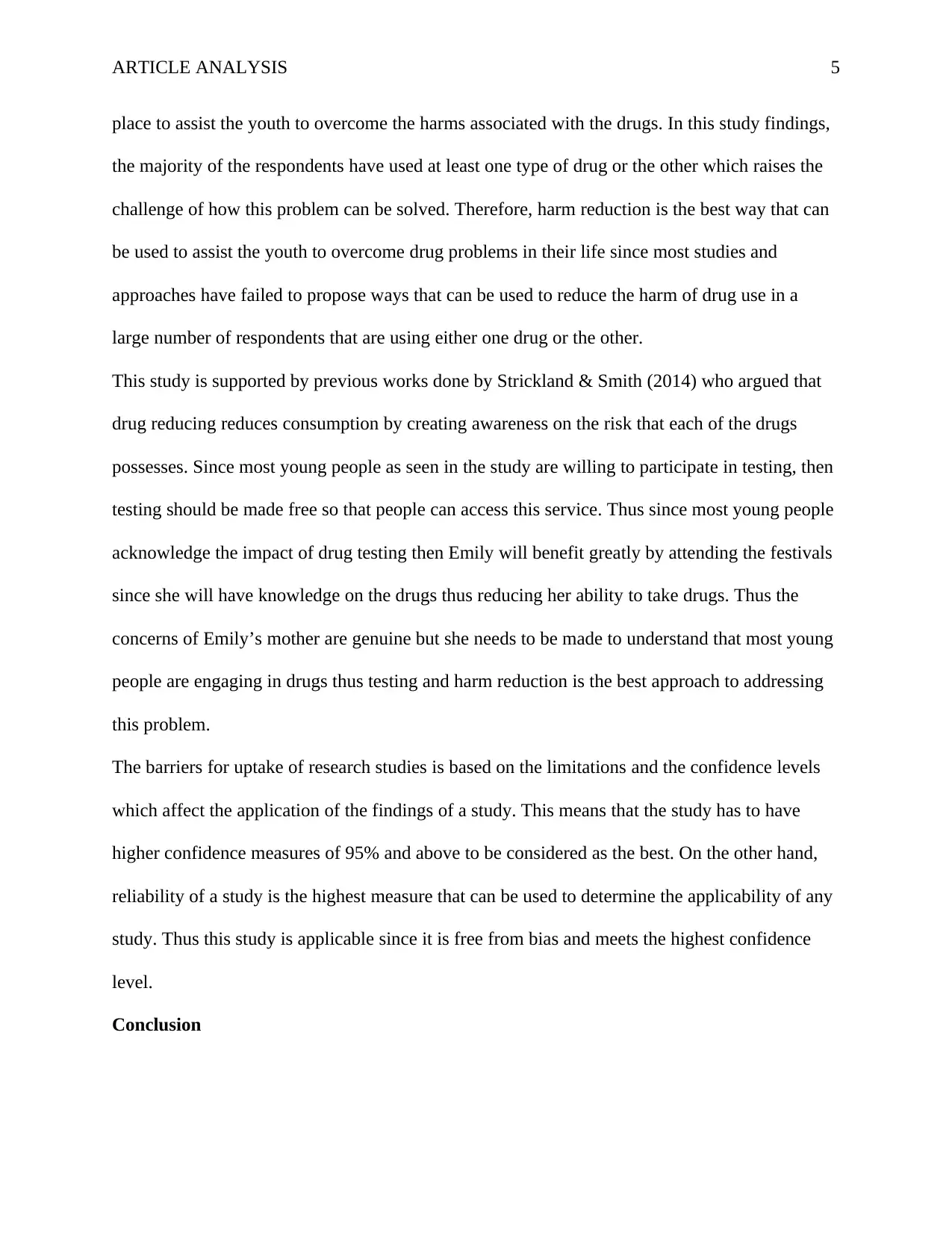
ARTICLE ANALYSIS 5
place to assist the youth to overcome the harms associated with the drugs. In this study findings,
the majority of the respondents have used at least one type of drug or the other which raises the
challenge of how this problem can be solved. Therefore, harm reduction is the best way that can
be used to assist the youth to overcome drug problems in their life since most studies and
approaches have failed to propose ways that can be used to reduce the harm of drug use in a
large number of respondents that are using either one drug or the other.
This study is supported by previous works done by Strickland & Smith (2014) who argued that
drug reducing reduces consumption by creating awareness on the risk that each of the drugs
possesses. Since most young people as seen in the study are willing to participate in testing, then
testing should be made free so that people can access this service. Thus since most young people
acknowledge the impact of drug testing then Emily will benefit greatly by attending the festivals
since she will have knowledge on the drugs thus reducing her ability to take drugs. Thus the
concerns of Emily’s mother are genuine but she needs to be made to understand that most young
people are engaging in drugs thus testing and harm reduction is the best approach to addressing
this problem.
The barriers for uptake of research studies is based on the limitations and the confidence levels
which affect the application of the findings of a study. This means that the study has to have
higher confidence measures of 95% and above to be considered as the best. On the other hand,
reliability of a study is the highest measure that can be used to determine the applicability of any
study. Thus this study is applicable since it is free from bias and meets the highest confidence
level.
Conclusion
place to assist the youth to overcome the harms associated with the drugs. In this study findings,
the majority of the respondents have used at least one type of drug or the other which raises the
challenge of how this problem can be solved. Therefore, harm reduction is the best way that can
be used to assist the youth to overcome drug problems in their life since most studies and
approaches have failed to propose ways that can be used to reduce the harm of drug use in a
large number of respondents that are using either one drug or the other.
This study is supported by previous works done by Strickland & Smith (2014) who argued that
drug reducing reduces consumption by creating awareness on the risk that each of the drugs
possesses. Since most young people as seen in the study are willing to participate in testing, then
testing should be made free so that people can access this service. Thus since most young people
acknowledge the impact of drug testing then Emily will benefit greatly by attending the festivals
since she will have knowledge on the drugs thus reducing her ability to take drugs. Thus the
concerns of Emily’s mother are genuine but she needs to be made to understand that most young
people are engaging in drugs thus testing and harm reduction is the best approach to addressing
this problem.
The barriers for uptake of research studies is based on the limitations and the confidence levels
which affect the application of the findings of a study. This means that the study has to have
higher confidence measures of 95% and above to be considered as the best. On the other hand,
reliability of a study is the highest measure that can be used to determine the applicability of any
study. Thus this study is applicable since it is free from bias and meets the highest confidence
level.
Conclusion

ARTICLE ANALYSIS 6
The debate on drug testing needs to include harm reduction so that people like Emily’s mother
can understand the benefits of this process. Research needs to be done so that strategies can be
developed on how to replicate drug testing in harm reduction and address the concerns of other
parents like Emily’s mother who see testing as a threat to their children.
The debate on drug testing needs to include harm reduction so that people like Emily’s mother
can understand the benefits of this process. Research needs to be done so that strategies can be
developed on how to replicate drug testing in harm reduction and address the concerns of other
parents like Emily’s mother who see testing as a threat to their children.
⊘ This is a preview!⊘
Do you want full access?
Subscribe today to unlock all pages.

Trusted by 1+ million students worldwide
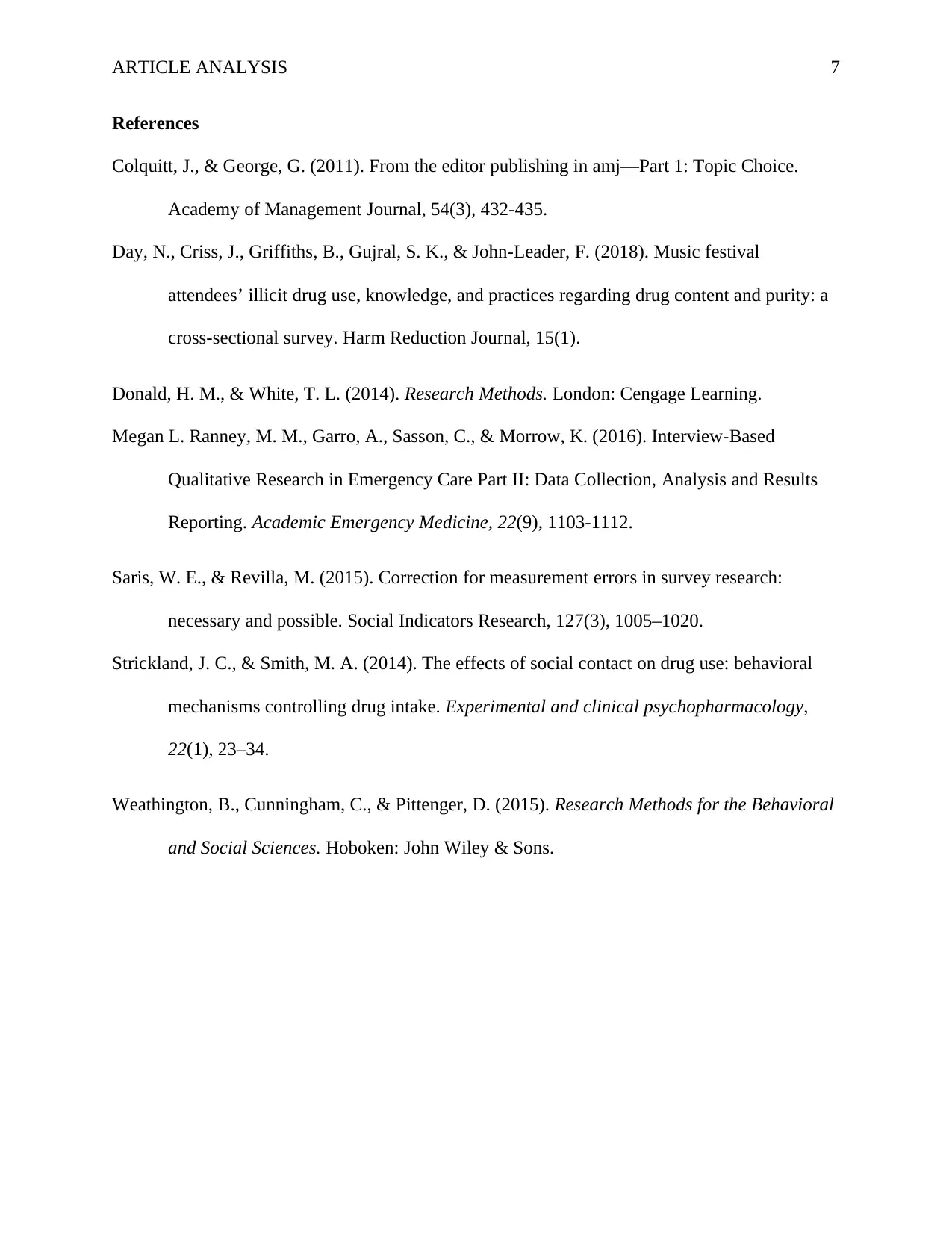
ARTICLE ANALYSIS 7
References
Colquitt, J., & George, G. (2011). From the editor publishing in amj—Part 1: Topic Choice.
Academy of Management Journal, 54(3), 432-435.
Day, N., Criss, J., Griffiths, B., Gujral, S. K., & John-Leader, F. (2018). Music festival
attendees’ illicit drug use, knowledge, and practices regarding drug content and purity: a
cross-sectional survey. Harm Reduction Journal, 15(1).
Donald, H. M., & White, T. L. (2014). Research Methods. London: Cengage Learning.
Megan L. Ranney, M. M., Garro, A., Sasson, C., & Morrow, K. (2016). Interview-Based
Qualitative Research in Emergency Care Part II: Data Collection, Analysis and Results
Reporting. Academic Emergency Medicine, 22(9), 1103-1112.
Saris, W. E., & Revilla, M. (2015). Correction for measurement errors in survey research:
necessary and possible. Social Indicators Research, 127(3), 1005–1020.
Strickland, J. C., & Smith, M. A. (2014). The effects of social contact on drug use: behavioral
mechanisms controlling drug intake. Experimental and clinical psychopharmacology,
22(1), 23–34.
Weathington, B., Cunningham, C., & Pittenger, D. (2015). Research Methods for the Behavioral
and Social Sciences. Hoboken: John Wiley & Sons.
References
Colquitt, J., & George, G. (2011). From the editor publishing in amj—Part 1: Topic Choice.
Academy of Management Journal, 54(3), 432-435.
Day, N., Criss, J., Griffiths, B., Gujral, S. K., & John-Leader, F. (2018). Music festival
attendees’ illicit drug use, knowledge, and practices regarding drug content and purity: a
cross-sectional survey. Harm Reduction Journal, 15(1).
Donald, H. M., & White, T. L. (2014). Research Methods. London: Cengage Learning.
Megan L. Ranney, M. M., Garro, A., Sasson, C., & Morrow, K. (2016). Interview-Based
Qualitative Research in Emergency Care Part II: Data Collection, Analysis and Results
Reporting. Academic Emergency Medicine, 22(9), 1103-1112.
Saris, W. E., & Revilla, M. (2015). Correction for measurement errors in survey research:
necessary and possible. Social Indicators Research, 127(3), 1005–1020.
Strickland, J. C., & Smith, M. A. (2014). The effects of social contact on drug use: behavioral
mechanisms controlling drug intake. Experimental and clinical psychopharmacology,
22(1), 23–34.
Weathington, B., Cunningham, C., & Pittenger, D. (2015). Research Methods for the Behavioral
and Social Sciences. Hoboken: John Wiley & Sons.
1 out of 7
Related Documents
Your All-in-One AI-Powered Toolkit for Academic Success.
+13062052269
info@desklib.com
Available 24*7 on WhatsApp / Email
![[object Object]](/_next/static/media/star-bottom.7253800d.svg)
Unlock your academic potential
Copyright © 2020–2025 A2Z Services. All Rights Reserved. Developed and managed by ZUCOL.





